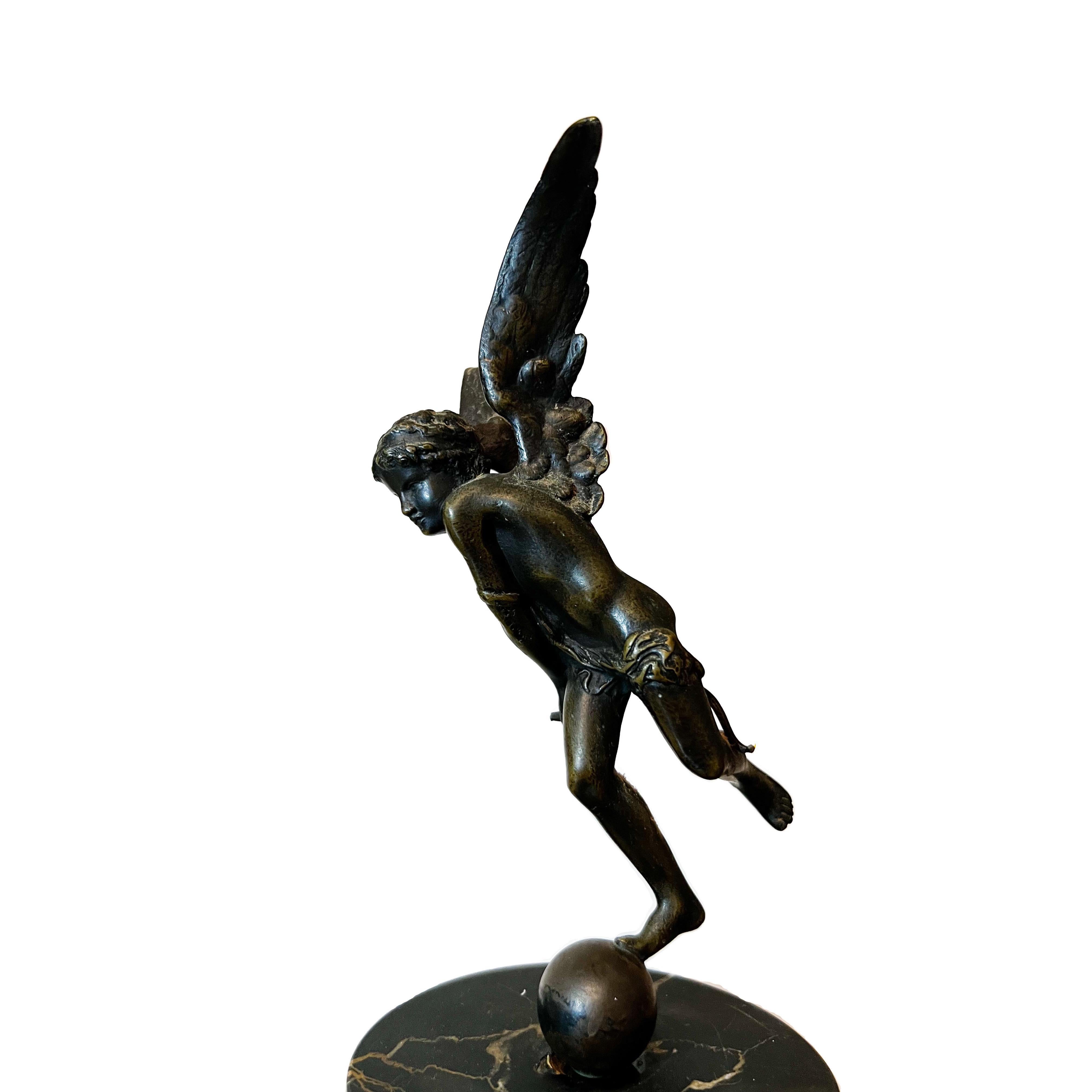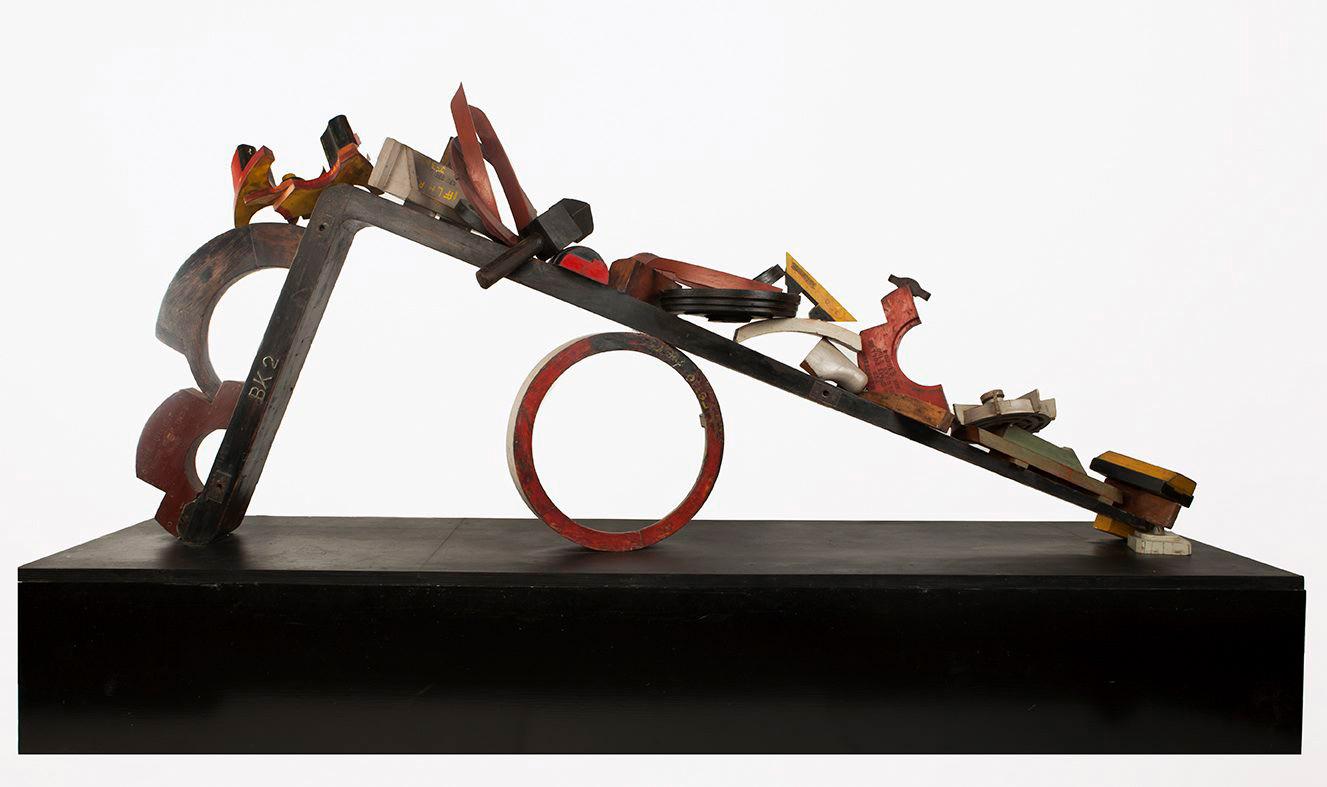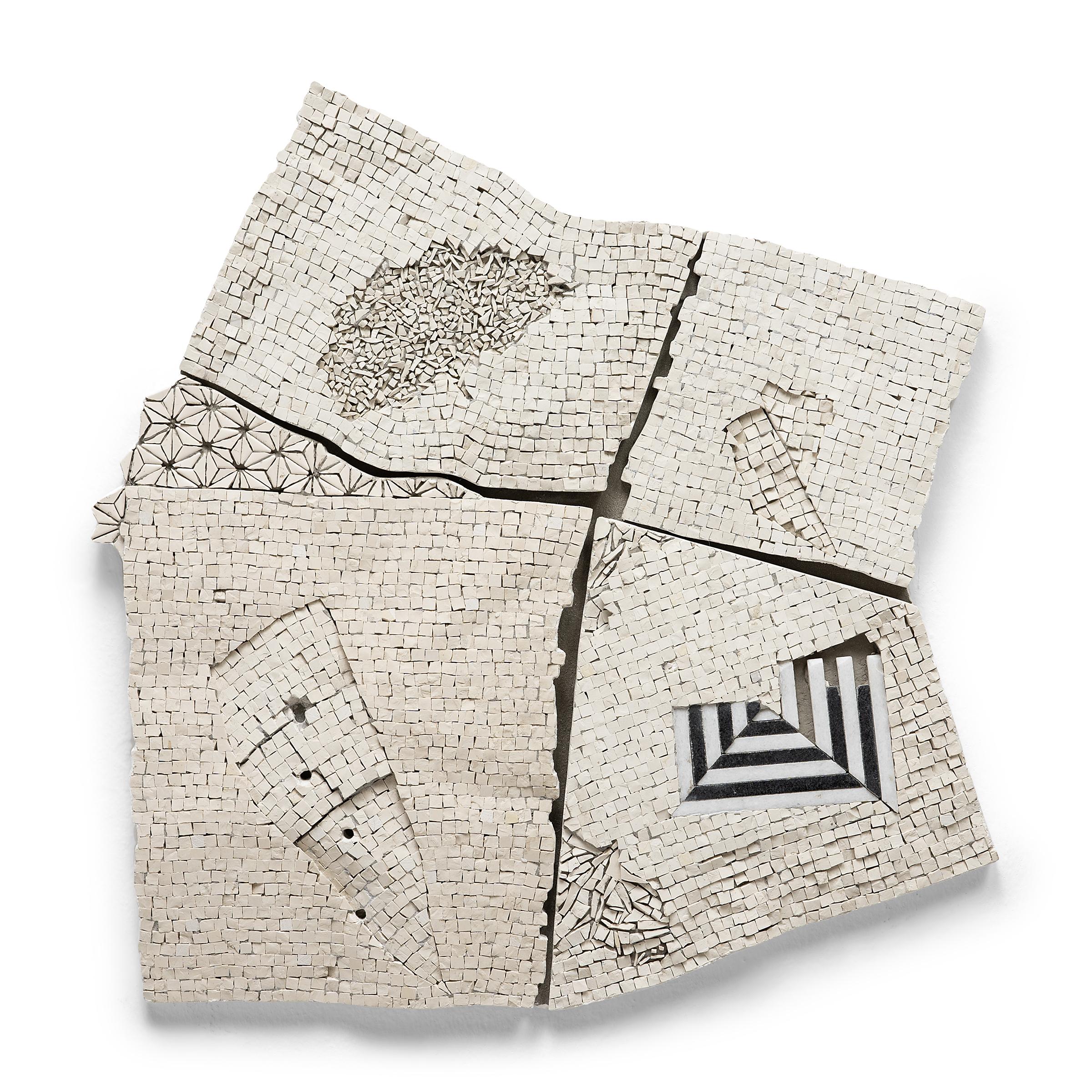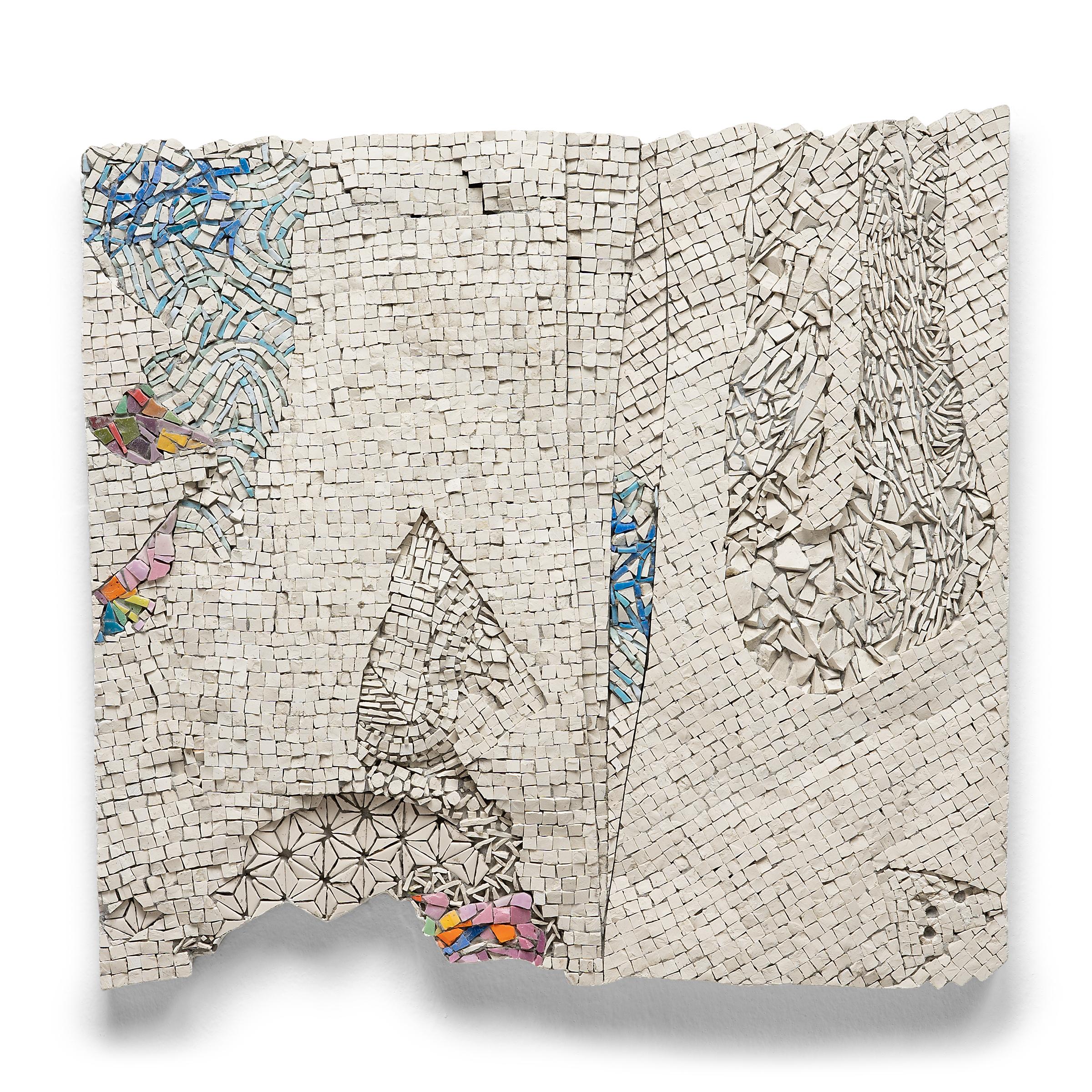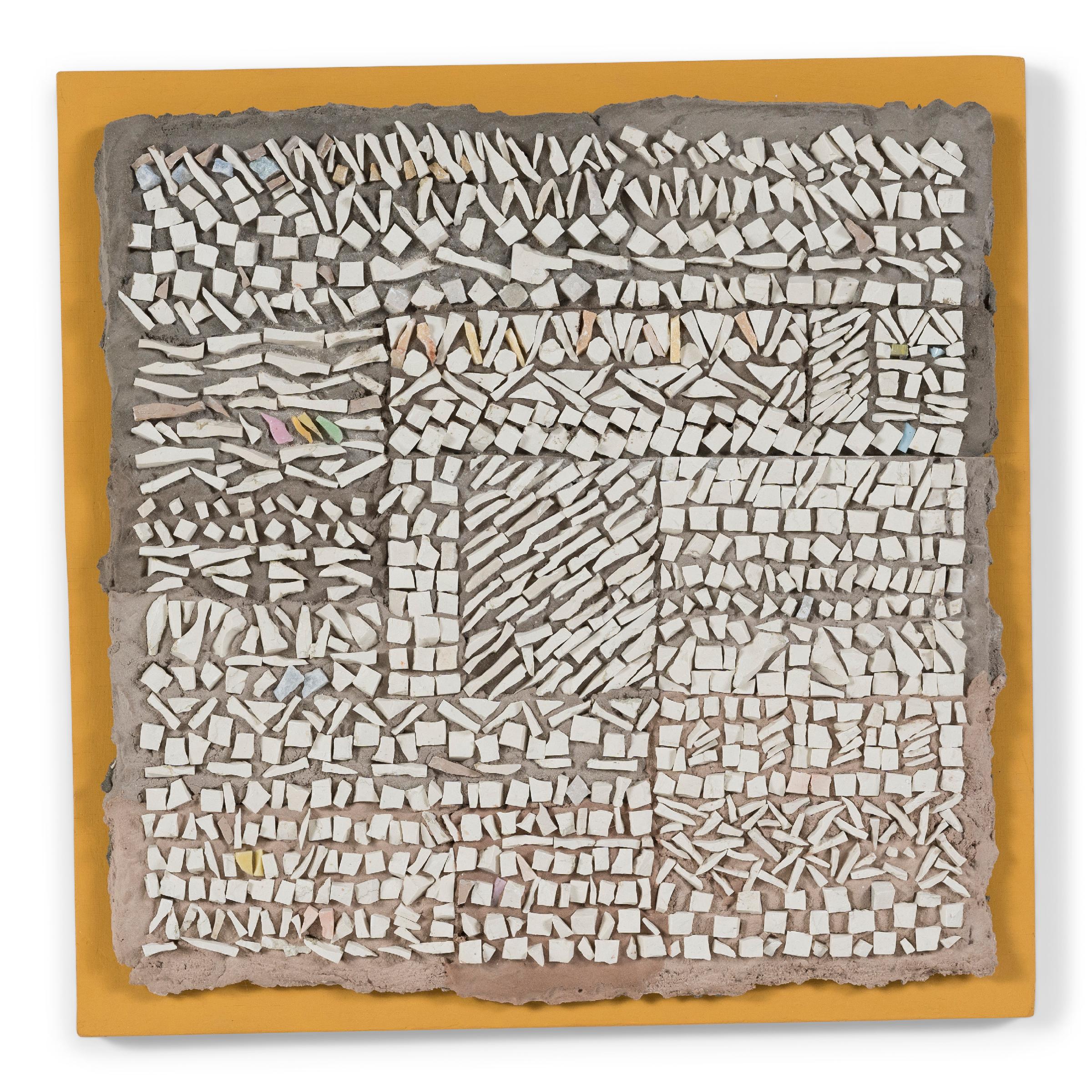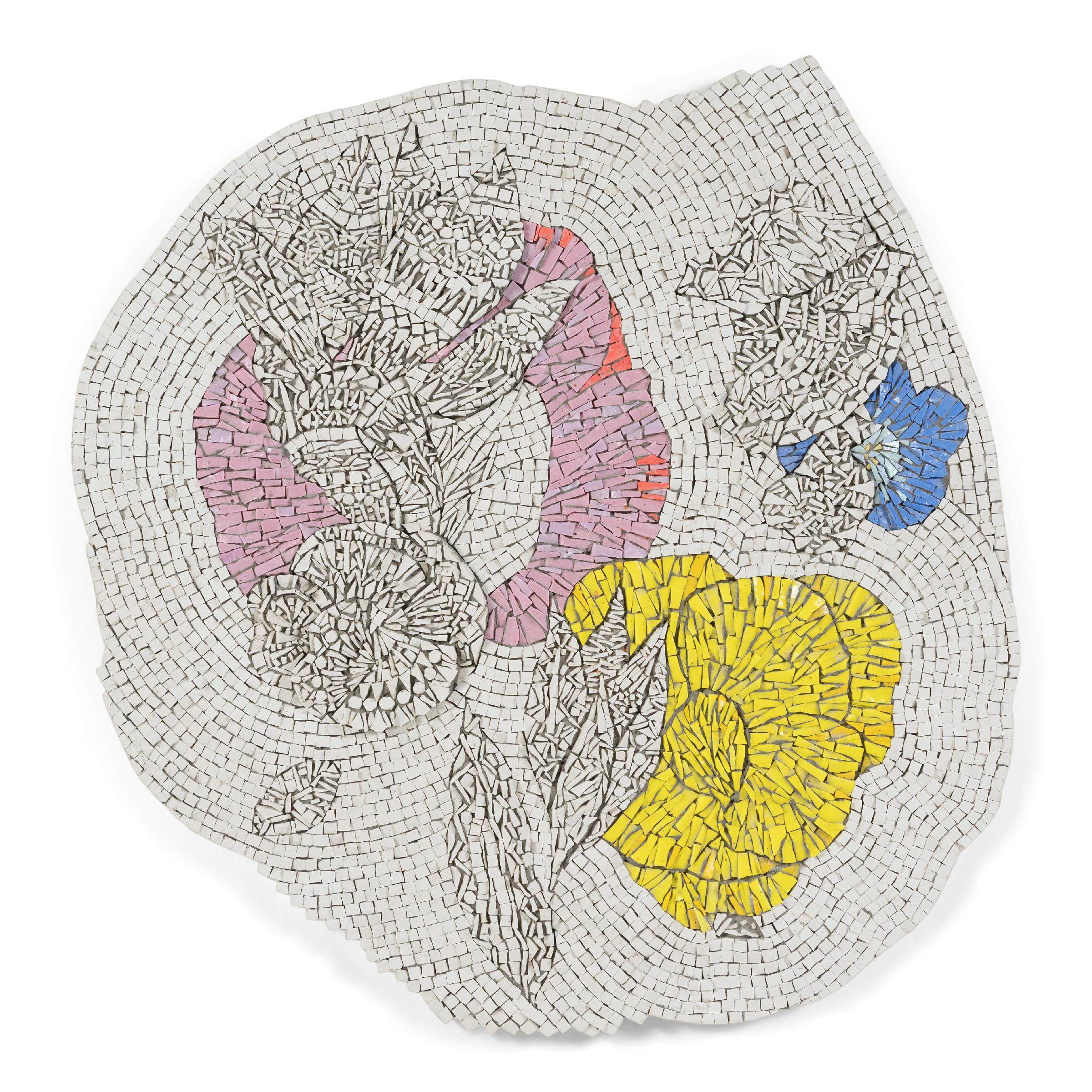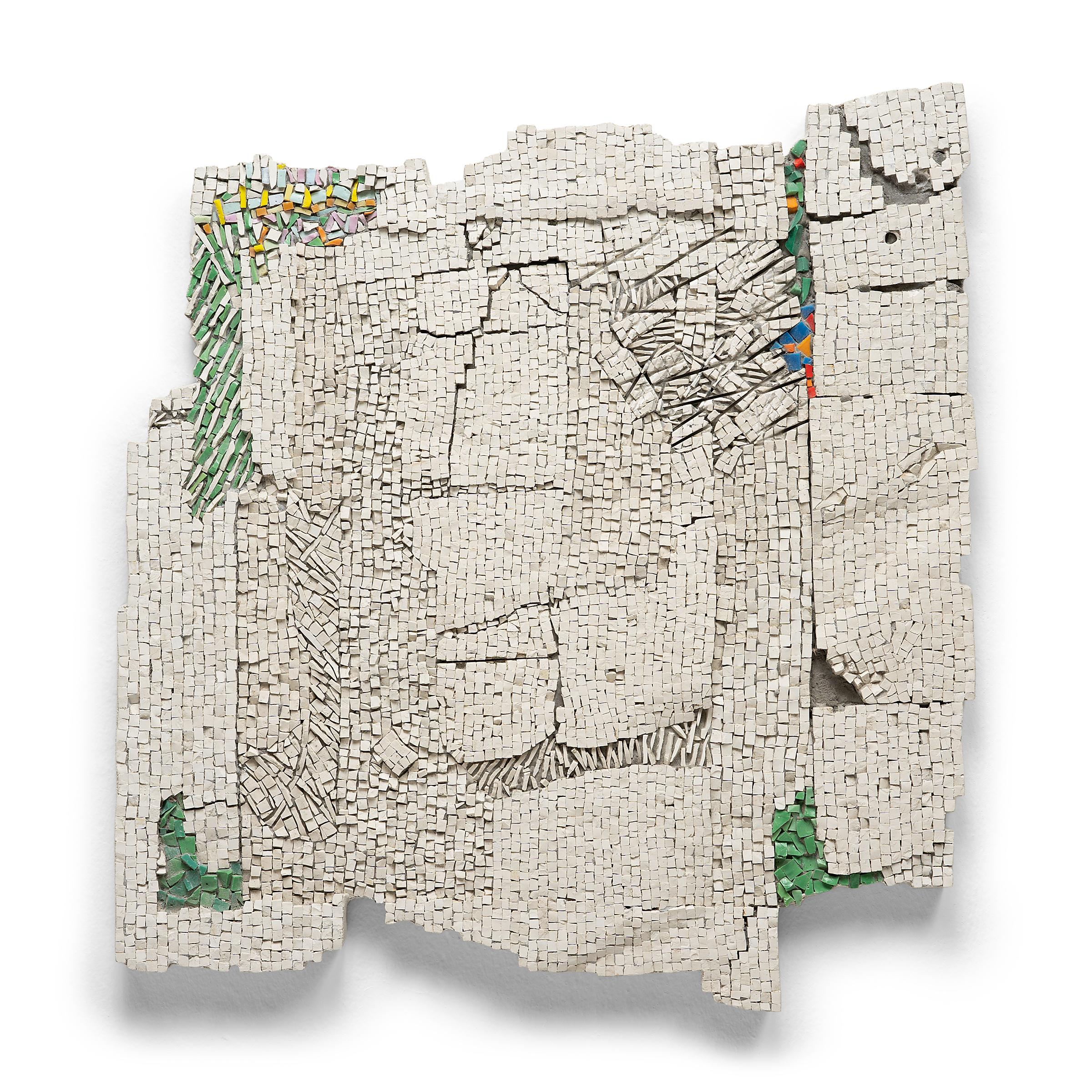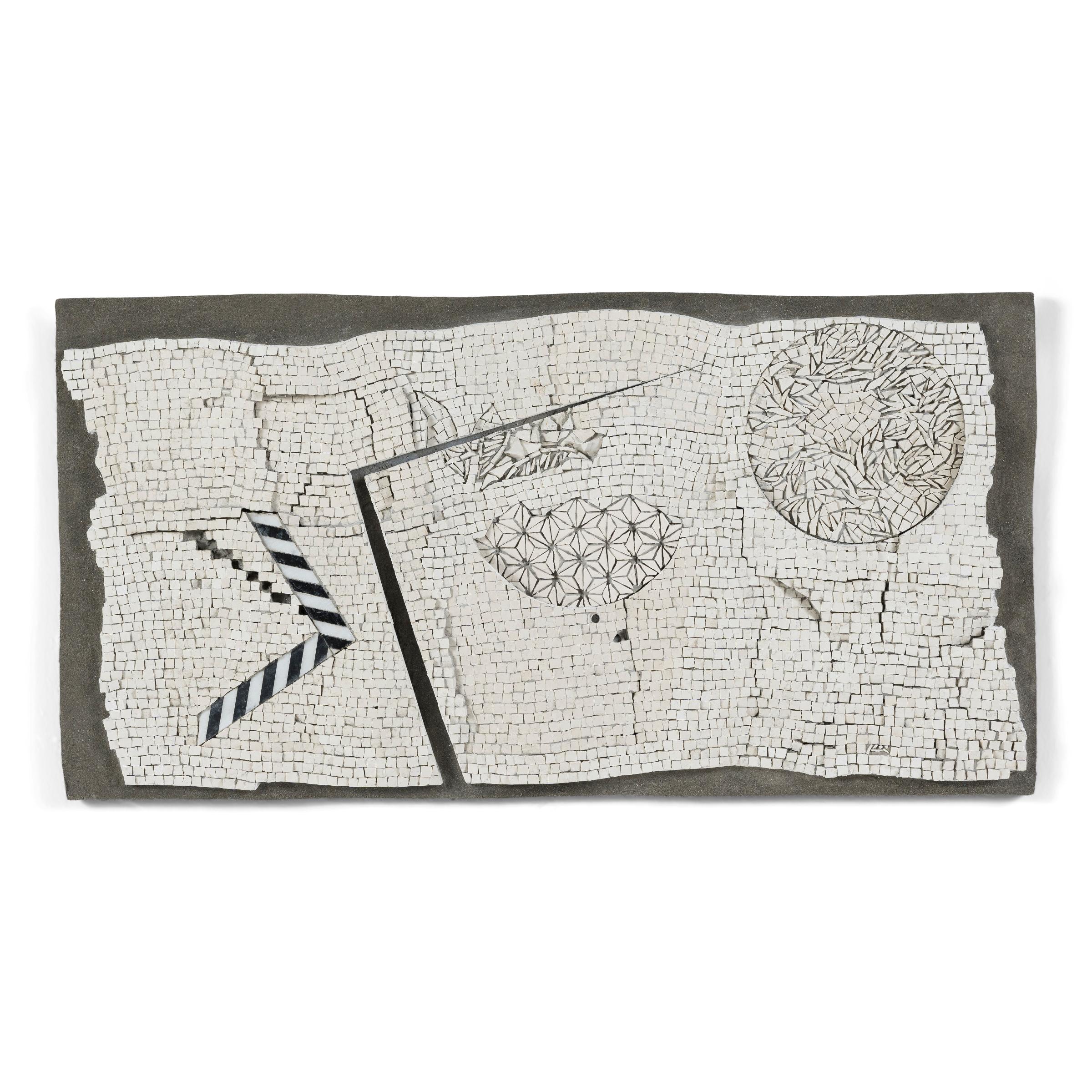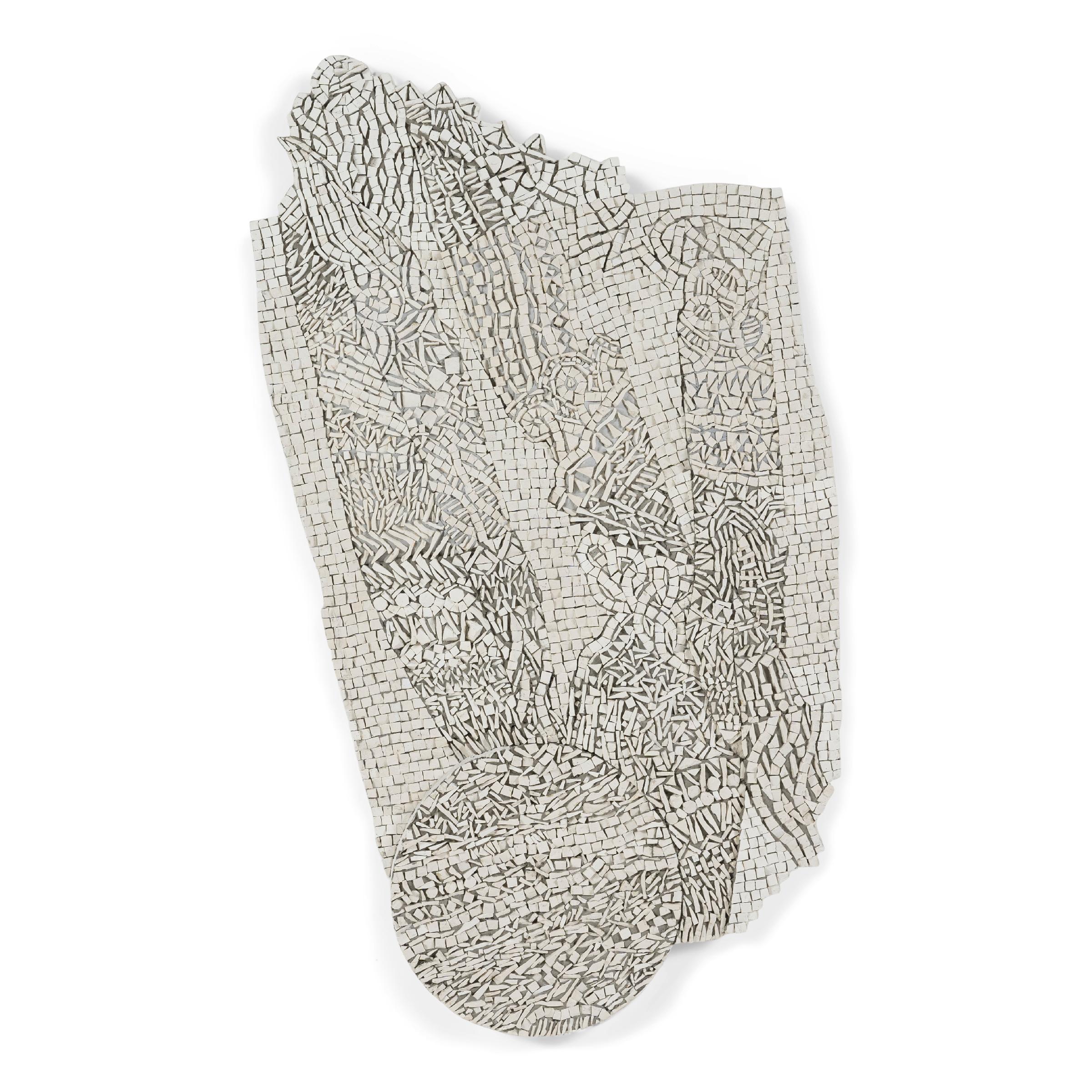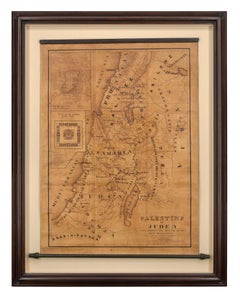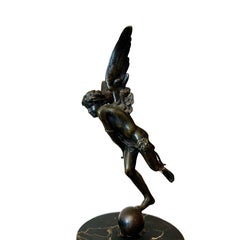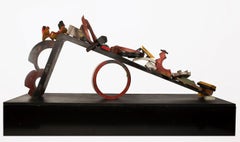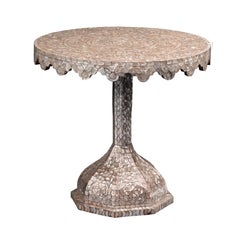
Mother of Pearl Inlaid Wooden Occasional Table
View Similar Items
Want more images or videos?
Request additional images or videos from the seller
1 of 3
Spanish Colonial Mother of Pearl Inlaid Wooden Occasional Table18th Century
18th Century
About the Item
- Creator:Spanish Colonial (1700 - 1799)
- Creation Year:18th Century
- Dimensions:Height: 21.5 in (54.61 cm)Width: 28 in (71.12 cm)Depth: 28 in (71.12 cm)
- Medium:
- Period:
- Condition:
- Gallery Location:New York, NY
- Reference Number:1stDibs: LU10211748572

About the Seller
5.0
Recognized Seller
These prestigious sellers are industry leaders and represent the highest echelon for item quality and design.
Established in 1997
1stDibs seller since 2012
17 sales on 1stDibs
More From This SellerView All
- Cuzco School Baptismal DishBy Spanish Colonial (Peruvian)Located in New York, NYProvenance: Manuel Ortíz de Zevallos y García, Peru; and by descent in the family to: Private Collection, New York. This impressive baptismal dish is an example of eighteenth-cent...Category
18th Century Old Masters Sculptures
MaterialsSilver
- Map of Palestine or Judea, Illustrating the History of the New TestamentBy Rev. Nathan B. RogersLocated in New York, NYPen and ink on paper, laid down on canvas, mounted to wooden scroll bars Signed and dated lower right: “Drawn by N. B. Rogers August. 1843” Inscribed with an ownership inscription on the verso: Rev. E. D. Daniels, Palmer, Mass. Provenance: Rev. Eugene Davidson Daniels, Palmer, Massachusetts, 1871 This extraordinary manuscript map is a rare survivor of the devotional and educational culture of New England in the first half of the nineteenth century. Although at first glance resembling a large-scale engraving or printed publication, this precisely rendered wall map was entirely drawn by hand, the product of meticulous research by a minister working in isolation in rural Maine. The map shows New Testament era cities, towns, tribal areas, and political borders as well as physical features such as rivers, lakes, mountains, and hills (indicated by half-tone cross-hatching). On to this geographically accurate rendering of the Holy Land, Rogers has located and inscribed significant locales mentioned in the Gospels and has annotated these places with relevant citations from the Bible. He further records these by plotting the travels of Jesus on what resemble a series of trails across the Holy Land. Each is distinguished by a different pattern of dots and dashes – correlated to an explanatory table at the lower right. From this we know that these lines document the “Flight into Egypt and return,” “Travels of Christ from Nazareth to Jerusalem and return,” “Travels from the commencement of his Ministry to the first Passover,” “Travels from the first and the second Passover,” “Travels from Jerusalem to Galilee after the 2nd Passover,” and “Travels from the third Passover to the Crucifixion.” An inset map of “Jerusalem...Category
19th Century More Art
MaterialsCanvas, Paper, Ink, Pen
- Madonna and Child with Angels in the CloudsLocated in New York, NYProvenance: Charles H. and Virginia Baldwin, Claremont, Colorado Springs, Colorado ca. 1907-1934; thence by descent until sold in 1949 to: Charles Blevins Davis, Claremont (renamed Trianon), Colorado Springs 1949 -until gifted in 1952 to: The Poor Sisters of Saint Francis, Trianon, Colorado Springs, 1952 until acquired, 1960, by: John W. Metzger, Trianon, renamed as the Trianon School of Fine Arts, Colorado Springs, 1960-1967; when transferred to: The Metzger Family Foundation, Trianon Art Museum, Denver, 1967 - 2004; thence by descent in the Metzger Family until 2015 Exhibited: Trianon Art Museum, Denver (until 2004) The present work is a spectacular jewel-like canvas by Amigoni, rich in delicate pastel colors, most likely a modello for an altarpiece either lost or never painted. In it the Madonna stands firmly upon a cloud in the heavens, her Child resting on a delicate veil further supported by a cloud, as he gently wraps his arm around his mother’s neck. From above angels prepare to lower flowers and a wreath, while other angels and seraphim surrounding the two joyfully cavort. Dr. Annalisa Scarpa, author of the forthcoming monograph on Jacopo Amigoni...Category
18th Century and Earlier Figurative Paintings
MaterialsCanvas, Oil
- Portrait of Laura Keppel, later Lady SouthamptonBy Sir John HoppnerLocated in New York, NYInscribed, upper left: “Miss Laura Keppel” Provenance: Commissioned from the artist and by descent in the Keppel family estate, Lexham Hall, Norfolk, to: Major Bertram William Arnol...Category
18th Century Paintings
MaterialsCanvas, Oil
- The Story of Joseph from the Second Baptistery Doors, Florence (“The Gates of PaBy Ferdinand BarbedienneLocated in New York, NYFerdinand Barbedienne (Saint-Martin-de-Fresnay 1810 – 1892 Paris) after Lorenzo Ghiberti (Florence, 1378 – 1455) Signed at the lower right of the principal relief: F. BARBEDIENNE Provenance: Private Collection, USA. Barbedienne’s “Gates of Paradise” reliefs are one of the triumphs of nineteenth-century bronze casting and patination. The nine panels that comprise our example are half-size reductions of the famous originals by Lorenzo Ghiberti, made for the Baptistery of Florence and now housed in the Museo del Opera del Duomo. Mounted in an impressive, mullioned frame surround, our work is an exceptional exemplar of the Renaissance Revival, the broadly influential style and movement that infused architecture, design, and artistic culture in the latter half of the nineteenth century. The central scene, The Story of Joseph, is perhaps the most celebrated of the entire series depicting as it does seven episodes from the Biblical narrative integrated into a single composition: Joseph cast by his brethren into the well, Joseph sold to the merchants, the merchants delivering Joseph to the pharaoh, Joseph interpreting the pharaoh’s dream, the pharaoh paying him honor, Jacob sending his sons to Egypt, and Joseph recognizes his brothers and returns home. The surrounding reliefs—two vertical figures in niches, two recumbent figures, and four portrait heads in roundels—are as well faithful reductions of Ghiberti’s original bronzes on other parts of the doors. The maker of these casts was the renowned 19th-century French fondeur Ferdinand Barbedienne. Gary Radke has recently written of this great enterprise: “The Parisian bronze caster Ferdinand Barbedienne began making half-sized copies of ancient and Renaissance sculpture in the 1830s. His firm benefitted enormously from the collaboration of Achille Collas, whom Meredith Shedd has shown was one of numerous pioneers in the mechanical reproduction of sculpture. Their competitors largely devoted themselves to reproducing relief sculpture, but Collas devised a process for creating fully three-dimensional copies. A tracing needle, powered by a treadle, moved over the surface of a full-sized plaster cast or bronze of the original and triggered a complementary action in a cutting stylus set over a soft plaster blank…He signed an exclusive contract with Barbedienne on November 29, 1838, and won medals for his inventions in 1839 and 1844. Barbedienne’s half-sized copies of the Gates of Paradise were famous not only for their fidelity to the original, but also for the way their gilding…suggested the glimmering surface that was hidden under centuries of dirt. Some critics even saw Collas’s and Barbedienne’s work as ‘philanthropic, an exemplary adaptation of industry to the requirements of art, the artist, the workers, and the public alike.’ At 25,000 francs, Collas’s and Barbedienne’s reduction of the Gates of Paradise was singularly more expensive than any other item for sale in their shop. All the reliefs, individual statuettes, and busts were cast separately and could be purchased either by the piece or as an ensemble. Fittingly, Barbedienne’s accomplishment earned him the Grand Prix at the 1878 Paris Exposition Universelle, along with numerous other medals.” Three complete examples of the Barbedienne-Ghiberti doors are known. One, first installed in a chapel in the Villa Demidoff of San Donato near Pratolino, was later acquired by William Vanderbilt...Category
Late 19th Century Figurative Sculptures
MaterialsBronze
- The Resurrection of ChristLocated in New York, NYProvenance: with “Mr. Scheer,” Vienna, by July 1918; where acquired by: Jindřich Waldes, Prague, 1918–1941; thence by descent to: Private Collection, New York Literature: Rudolf Kuchynka, “České obrazy tabulové ve Waldesově obrazárně,” Památky archeologické, vol. 31 (1919), pp. 62-64, fig. 5. Jaroslav Pešina, “K datování deskových obrazů ve Waldesově obrazárně,” Ročenka Kruhu pro Pěstování Dějin Umění: za rok (1934), pp. 131-137. Jaroslav Pešina, Pozdně gotické deskové malířství v Čechách, Prague, 1940, pp. 150-151, 220. Patrik Šimon, Jindřich Waldes: sběratel umění, Prague, 2001, pp. 166, 168, footnote 190. Ivo Hlobil, “Tři gotické obrazy ze sbírky Jindřicha Waldese,” Umění, vol. 52, no. 4 (2004), p. 369. Executed sometime in the 1380s or 1390s by a close associate of the Master of the Třeboň Altarpiece, this impressive panel is a rare work created at the royal court in Prague and a significant re-discovery for the corpus of early Bohemian painting. It has emerged from an American collection, descendants of the celebrated Czech industrialist and collector Jindřich Waldes, who died in Havana fleeing Nazi-occupied Europe. The distinctive visual tradition of the Bohemian school first began to take shape in the middle of the fourteenth century after Charles IV—King of Bohemia and later Holy Roman Emperor—established Prague as a major artistic center. The influx of foreign artists and the importation of significant works of art from across Europe had a profound influence on the development of a local pictorial style. Early Italian paintings, especially those by Sienese painters and Tommaso da Modena (who worked at Charles IV’s court), had a considerable impact on the first generation of Bohemian painters. Although this influence is still felt in the brilliant gold ground and the delicate tooling of the present work, the author of this painting appears to be responding more to the paintings of his predecessors in Prague than to foreign influences. This Resurrection of Christ employs a compositional format that was popular throughout the late medieval period but was particularly pervasive in Bohemian painting. Christ is shown sitting atop a pink marble sarcophagus, stepping down onto the ground with one bare foot. He blesses the viewer with his right hand, while in his left he holds a triumphal cross with a fluttering banner, symbolizing his victory over death. Several Roman soldiers doze at the base of the tomb, except for one grotesque figure, who, beginning to wake, shields his eyes from the light and looks on with a face of bewilderment as Christ emerges from his tomb. Christ is wrapped in a striking red robe with a blue interior lining, the colors of which vary subtly in the changing light. He stands out prominently against the gold backdrop, which is interrupted only by the abstractly rendered landscape and trees on either side of him. The soldiers’ armor is rendered in exacting detail, the cool gray of the metal contrasting with the earth tones of the outer garments. The sleeping soldier set within a jumble of armor with neither face nor hands exposed, is covered with what appears to be a shield emblazoned with two flies on a white field, somewhat resembling a cartouche (Fig. 1). This may be a heraldic device of the altarpiece’s patron or it may signify evil, referencing either the Roman soldiers or death, over both of which Christ triumphs. This painting formed part of the collection assembled by the Czech industrialist and founder of the Waldes Koh-i-noor Company, Jindřich Waldes, in the early twentieth century. As a collector he is best remembered for establishing the Waldes Museum in Prague to house his collection of buttons (totaling nearly 70,000 items), as well as for being the primary patron of the modernist painter František Kupka. Waldes was also an avid collector of older art, and he approached his collecting activity with the goal of creating an encyclopedic collection of Czech art from the medieval period through to the then-present day. At the conclusion of two decades of collecting, his inventory counted 2331 paintings and drawings, 4764 prints, and 162 sculptures. This collection, which constituted the Waldesova Obrazárna (Waldes Picture Gallery), was first displayed in Waldes’ home in Prague at 44 Americká Street and later at his newly built Villa Marie at 12 Koperníkova Street. This Resurrection of Christ retains its frame from the Waldes Picture Gallery, including its original plaque “173 / Česky malíř z konce 14 stol.” (“Czech painter from the end of the 14th century”) and Waldes’ collection label on the reverse. The Resurrection of Christ was one of the most significant late medieval panel...Category
15th Century and Earlier Old Masters Paintings
MaterialsTempera, Panel
You May Also LikeView All
- Metal Classical Style Sculpture of AnterosLocated in Troy, NYThis European metal sculpture, most likely bronze or brass, is probably Anteros, God of requited love. The piece altogether is 18" in height; the figure itself 7.25". The bottom and...Category
Late 19th Century Romantic Figurative Sculptures
MaterialsMarble, Metal
$760 Sale Price20% Off - Opus 800, wooden assemblage modern art sculpture by Robert KlippelBy Robert KlippelLocated in Zug, CHROBERT KLIPPEL (1920-2001) Opus 800 1989 Painted wood assemblage 146 x 334.5 x 85 cm 57.48 x 131.69 x 33.46 inches Cat. rais. no. 800 Regarded as Australia’s leading sculptor, Rober...Category
20th Century Abstract Sculptures
MaterialsWood
- Listening at the Cliffside, Original Contemporary Wooden Mixed Media SculptureLocated in Boston, MAListening at the Cliffside, Original Contemporary Wooden Mixed Media Sculpture 20" x 65" x 42" (HxWxD) Wood, Stone, String, Brass Bell, Glass Bottle, Clear Finish In this highly conceptual work, artist Todd McCollister has combined a myriad of elements to depict a narrative scene that makes the viewer pause. Inspired by historical elements, the work explores space, structure, and sound. A small boat-shaped after shave bottle serves as a floating element beneath a brass bell. A wall of undulating wood creates the cliffside, while more delicate beams of wood jut behind the piece, somehow evoking both fragility and the integrity of industrial engineering at work. Artist Commentary: This piece started as a reference to the "acoustic mirror" listening stations on the southeast coast of England. These huge concrete parabolic reflectors focus sound to a small point. During the second world war, the British posted soldiers at the focus of each one, where they would listen for German boats...Category
21st Century and Contemporary Contemporary Sculptures
MaterialsStone, Brass
- Fully Restored 1891 Pease Upright PianoLocated in Chico, CAThe instrument is done in a Brazilian Rosewood finish and is of the carved Victorian style. The piano has been fully restored and refinished, inside and out, and the restoration was ...Category
1890s Victorian More Art
MaterialsRosewood, Wood
$35,750 Sale Price35% Off - "Landscape Divided, " Mixed Media Mosaic, 2023Located in Chicago, ILIntricate, ethereal and highly textured, the abstract compositions of Japanese mosaic artist Toyoharu Kii reflect a sophisticated approach to the technical art of mosaic making. Clas...Category
21st Century and Contemporary Abstract More Art
MaterialsMarble
- "Hidden Movements, " Mixed Media Mosaic, 2023Located in Chicago, ILMonochromatic, ethereal and highly textured, the abstract compositions of Japanese mosaic artist Toyoharu Kii reflect a sophisticated approach to the tech...Category
21st Century and Contemporary Abstract Geometric More Art
MaterialsMarble
